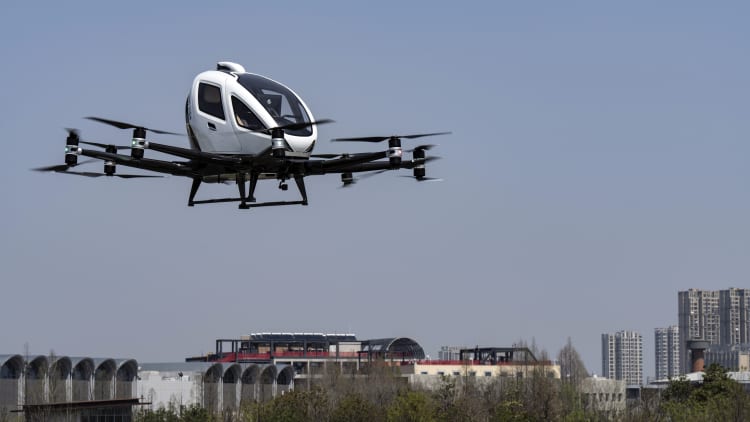Chinese drone maker Ehang Inc. on Wednesday unveiled what it calls the world's first drone capable of carrying a human passenger.
The Guangzhou, China-based company pulled the cloth off the Ehang 184 at the Las Vegas Convention Center during the CES gadget show. In a company video showing it flying, it looks like a small helicopter but with four doubled propellers spinning parallel to the ground like other drones.
The electric-powered drone can be fully charged in two hours, carry up to 220 pounds and fly for 23 minutes at sea level, according to Ehang. The cabin fits one person and a small backpack and even has air conditioning and a reading light. With propellers folded up, it's designed to fit in a single parking spot.
After setting a flight plan, passengers only need to give two commands, "take off" and "land," each controlled by a single click on a Microsoft Surface tablet, the company said.
It is designed to fly about 1,000 to 1,650 feet off the ground with a maximum altitude of 11,500 feet and top speed of 63 miles per hour.
U.S. authorities are just starting to lay out guidelines for drone use, and a human-passenger drone seems certain to face strict scrutiny.
Federal Aviation Administration administrator Michael Huerta was at CES but could not immediately be reached for comment through a spokesman.
Ehang co-founder and Chief Financial Officer Shang Hsiao said the company hopes to sell the device for $200,000 to $300,000 beginning this year but acknowledged it occupies a legal "grey area."
"The whole world never had something like this before," he said.
A passenger would have no controls as a backup, he said. In the event of a problem the company plans a remote control center that would take over the vehicle and ensure it lands safely, he said.
Chief Marketing Officer Derrick Xiong said the vehicle has been flown more than 100 times at low altitudes in a forested area in Guangzhou, including several times with a person inside.
One thing that makes quad-copters safer than helicopters are its numerous propellers, Xiong said. Even if three of the four arms have their six propellers disabled, the final arm's working propellers can ensure a rough landing by spiraling toward the ground, he said.
The company, which also makes smaller drones, said in August it had raised $42 million in capital from various investors including GP Capital, GGV Capital, ZhenFund and others, following $10 million in capital raised the previous year.



